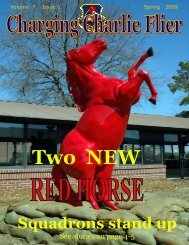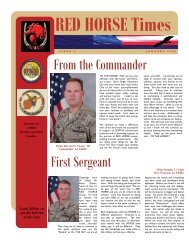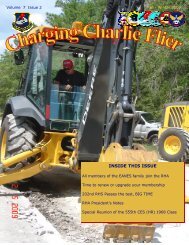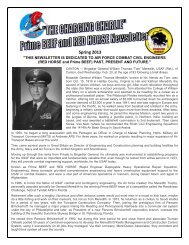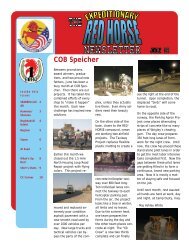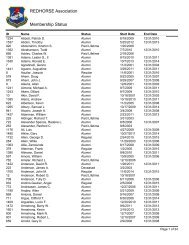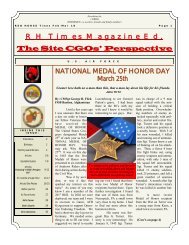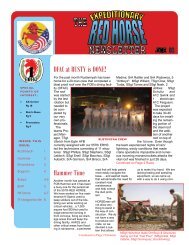1erhgnewsletterdec09.. - Red Horse Association
1erhgnewsletterdec09.. - Red Horse Association
1erhgnewsletterdec09.. - Red Horse Association
Create successful ePaper yourself
Turn your PDF publications into a flip-book with our unique Google optimized e-Paper software.
Rapid Engineer Deployable Heavy Operational Repair Squadron Engineers [RED HORSE]<br />
Civil Engineering REDHORSE units are trained and equipped to make heavy repairs, upgrade airfields and<br />
facili-ties, and support weapons systems deployment to theaters of operations.<br />
In Southwest Asia, PRIME BEEF teams filled a need for short term construction capabilities. However, the<br />
Air Force needed a stable and longer term heavy repair capability. The response was to organize two 400 man (12<br />
offi-cers and 388 airmen) Heavy Repair Squadrons. These units, the 555th (Triple Nickel) and the 554th (Penny<br />
Short) Civil Engineering Squadrons were then activated in October 1965. After nine weeks of training at Cannon<br />
Air Force Base, New Mexico, the 555th was deployed to Cam Ranh Bay Air Base and the 554th to Phan Rang Air<br />
Base in Vietnam.<br />
Upon arrival in Vietnam, REDHORSE squadrons repaired aluminum matting runways, drilled wells to obtain<br />
pota-ble water, quarried and crushed stone for roads and runways, repaired mortar damage caused by enemy<br />
attacks, constructed and upgraded operational facilities and housing, erected aircraft revetments, and installed<br />
aircraft ar-resting barriers and airfield lighting systems. By 1967, six REDHORSE squadrons had been trained,<br />
organized, and deployed to Southeast Asia - five to South Vietnam and one to Thailand. At the peak of their activity,<br />
RED-HORSE total strength reached 2,400 military and more than 6,000 (Vietnamese and Thai) nationals.<br />
REDHORSE squadrons also had a combat capability that was frequently used. REDHORSE Combat Defense<br />
Teams were often called upon to man defensive positions. In addition to their military duties, many team<br />
members were active in the Civic Action Program during their off duty hours. Materials not used or unfit for use on<br />
base pro-jects were given to the local population and volunteers frequently worked with Vietnamese nationals to<br />
complete various building projects. REDHORSE volunteers helped to rebuild homes damaged by fire, weather, or<br />
war and also worked at refugee camps, orphanages, and local schools to improve the quality of life for Vietnamese<br />
civilians.<br />
Today, RED HORSE units continue to provide the Air Force with a highly mobile civil engineering response<br />
force to support contingency and special operations worldwide. They remain self sufficient, mobile units capable of<br />
rapid response and independent operations in remote, high-threat environments worldwide. They provide heavy<br />
repair capability and construction support when requirements exceed normal base civil engineer capabilities and<br />
where Army engineer support is not readily available. They accomplish major airfield construction and repair work<br />
in for-ward locations requiring an organic logistics capability, including vehicle maintenance, food service, supply,<br />
and logistics plans.<br />
“COMMANDER’S CORNER”<br />
Friends, Families and Fellow HORSEMEN,<br />
Greetings. Isn‘t it a great day to be an American Airman! It has been another action-packed month as our<br />
warriors continue to provide world-class service to the combined-joint team. During our travels, Chief Litke and I continue<br />
to be humbled and impressed with you, our Airmen and your accomplishments. Without exception, the feedback<br />
from those you are supporting (Army, Marines, Navy, and Air Force leadership of all ranks) is outstanding. Time and<br />
again we have heard ―we didn‘t know the Air Force had anything like the HORSE. Can you stay and do more?‖ The<br />
work is hard and the conditions extreme but your spirits remain high. There is a lot more work in the pipeline. Good<br />
work that only the HORSE can accomplish. Our planners, engineers, and logisticians are making tremendous strides in<br />
keeping the HORSE fed—ensuring that the next project is teed up ready. Some of these projects will take many of us<br />
to new and different locations. Remember, we are a nomadic organization and go to where our services are most<br />
needed. But for now, as it is the season for giving thanks, let me again thank you, your families, and your friends for<br />
the continued service and sacrifice. Each of you can take great pride in the contributions you are making to the overall<br />
mission success.<br />
TO THE HORSE!<br />
Douglas K. Tucker<br />
Commander



